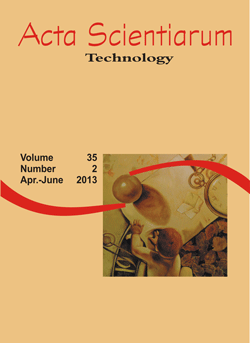<b>Endocrine disruptors in sludge wastewater treatment plants: environmental complications</b> - doi: 10.4025/actascitechnol.v35i2.10619
DOI:
https://doi.org/10.4025/actascitechnol.v35i2.10619Keywords:
ELISA, LC-MS/MS, water ecophysiology, aquatic ecotoxicology, human sewage, water pollution controlAbstract
Concern over exposure to endocrine disruptors (EDs) and impacts on wildlife and human has gradually increased in importance in recent years. Wastewater systematically receives most if not all of these chemicals, so a deeper understanding of the fate of EDs in environment is sorely needed. We evaluated EDs concentration in the affluent and effluent from the Sludge Wastewater Treatment Plants (SWTPs) Penha and Ilha do Governador. It was used as evaluation parameter the determination of some target compounds, such as: alkylphenols, 17β-estradiol, bisphenol A; complementing with measures of physical and chemical parameters: temperature, pH, dissolved oxygen, total suspended solids, volatile suspended solids, and total chemical oxygen demand. Samples were collected along the line of treatment of each SWTP, and after laboratory procedures, analyzed by LC-MS/MS and ELISA techniques. In some samples, we verified concentrations of chemical compounds with potential to disrupt the endocrine system of living organisms. Therefore, the release of this effluent, even within the effluent discharge standards (BRASIL, 2005) or in condition to be purified by the water course, may lead to physiological changes in the organisms of the receptor water body.
Â
Downloads
Downloads
Additional Files
- declaração de direito autoral (Português (Brasil))
- Desreguladores endócrinos em estações de tratamento de esgotos: Complicações ao meio ambiente (Português (Brasil))
- artigo corrigido portugues e ingles (Português (Brasil))
- declaração correções ingles (Português (Brasil))
- declaração correções portugues (Português (Brasil))
Published
How to Cite
Issue
Section
License
DECLARATION OF ORIGINALITY AND COPYRIGHTS
I Declare that current article is original and has not been submitted for publication, in part or in whole, to any other national or international journal.
The copyrights belong exclusively to the authors. Published content is licensed under Creative Commons Attribution 4.0 (CC BY 4.0) guidelines, which allows sharing (copy and distribution of the material in any medium or format) and adaptation (remix, transform, and build upon the material) for any purpose, even commercially, under the terms of attribution.
Read this link for further information on how to use CC BY 4.0 properly.



















8.png)




